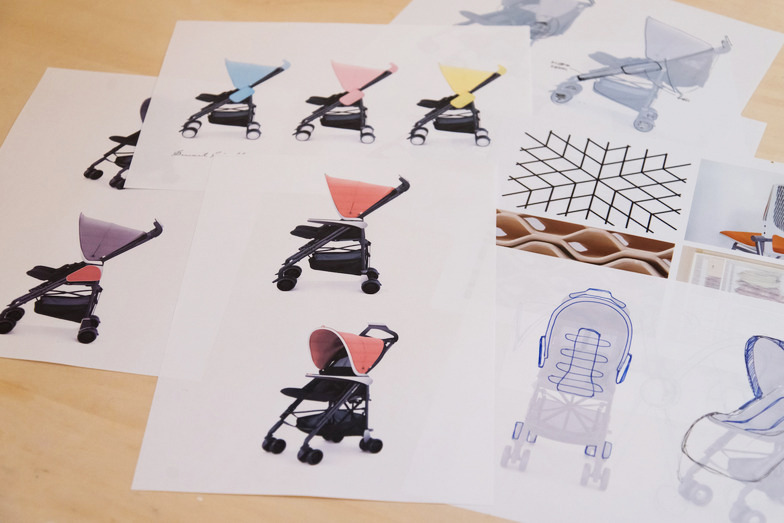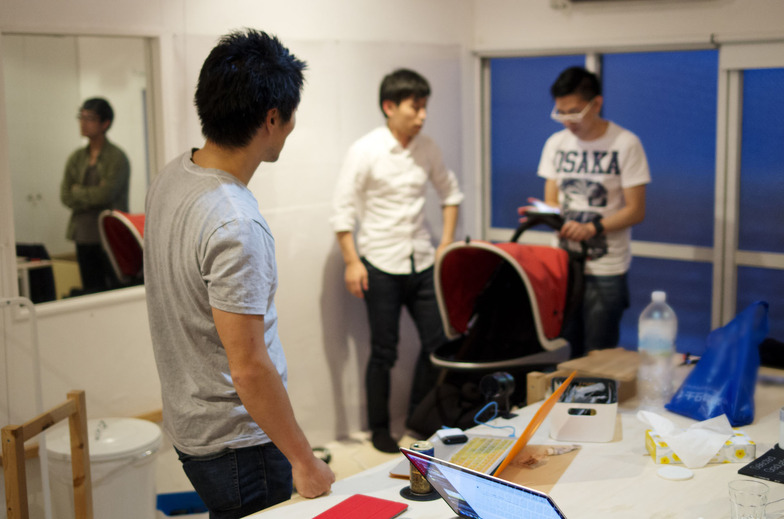Today, businesses, markets, and consumers alike are all navigating new environments. Marketing must now consider societal contexts and structures, demanding that advertising agencies clearly grasp the essence of challenges. At Dentsu Inc., projects have launched to identify actual issues and conduct prototyping and R&D based on them.
This series introduces new communication initiatives that begin with problem discovery. This time, Takuya Takemoto and Yima Makai from Dentsu Inc. Communication Planning Center discuss the communication stroller " Smile Explorer " as an example of prototyping that transforms a product into a solution.
Changes in the Product Development Environment
I'm Makai, introducing our "Smile Explorer" this time.
The manufacturing environment is undergoing dramatic changes. We've entered an era where anyone can easily prototype with just an idea and a little technology.
Amidst this, aided by the proliferation of smartphones, IoT products are emerging at an incredible pace.
As objects connect to the internet and smartphones, entirely new possibilities previously unimaginable for individual objects have opened up. This trend could be described as giving birth to new forms of communication, or perhaps as the mediafication of all things.
Furthermore, crowdfunding, a new funding mechanism, is accelerating this fresh manufacturing movement. The existence of platforms for announcing concepts has further elevated the value of prototyping.
As seen at this year's Cannes Lions, where products like Life Saving Dot, Hammerhead, and Owlet were highly praised as solutions to real problems, this trend is also impacting the advertising industry.
Prototyping as Experimentation
Amidst these environmental changes, how realistic a solution can product development by advertising agencies become?
We actually prototyped an IoT product.
That product is the "Smile Explorer."
This is an IoT stroller based on the concept of a "communication stroller that makes challenging travel times enjoyable."
By automatically capturing your baby's smiles during daily outings and recording them alongside location data, parents can discover their baby's favorite spots—places they might not have noticed before. They can then revisit these outing memories alongside the smiling photos.
(※For details, visit the project site: smile-explorer.com)
Why a stroller?
The idea started when I happened to see a mother walking in town with her smartphone attached to the stroller handle. The challenges faced by parents with babies are a socially recognized issue, yet there are still many unmet needs in this area. This project began from the belief that we could contribute to childcare support through the stroller product.
Prototyping this time yielded two key discoveries.
First, during the process of translating the concept into actual specifications, the core functions and the primary purpose of the product became much clearer.
As we refined the specifications, we developed a mindset of "If we can achieve this function, we can create this kind of value" and "To enhance that value, we could also consider this additional function." Moving back and forth between the actual functions and the value they deliver shaped our current concept.

Initially, the concept was a stroller that could realize various functions by linking with a smartphone, featuring parallel safety functions like auto-lock and convenience features like live view. However, a hypothesis emerged: "Amidst the challenges of parenting, are we overlooking our baby's precious moments and signals?" This led to the decision to make creating new parent-child communication the product's core value, centered around the "Smile Shutter" (smile detection feature). Additional features like "Smile Pin" (locating smiles on a map) and "Album Mode" were then added, deepening the concept.
As a result, possibilities for development using data emerged, extending beyond the product itself.
Second, actual prototyping clarified the product's ideal form. This prototype integrated the device with the stroller. However, we realized that for commercialization and sales, a design freely attachable to any standard stroller would reach more users and expand the market.
New Possibilities for the Product
From here, Takemoto will speak.
How about from the perspective of "the product as communication"?
Communication used in advertising primarily targets people's minds and hearts, often aiming to change their "attitudes." One characteristic of using a product is that it can more easily target changes in people's "actions" through the act of using the object itself, not just their attitudes.
Smile Explorer aimed to create new communication between parents and their babies, and to generate a positive chain of actions beyond that. We believe that by using this product, the baby's smile can serve as a signal, naturally creating previously nonexistent parent-child communication, and subsequently triggering new actions like, "Let's go out here next time."
Another objective is not only to help individual users enjoy parenting more, but also to contribute to broader parenting support through infrastructure and services by leveraging big data.
The accumulated big data from Smile Explorer—comprising stroller movement logs and smile location data—enables analysis from perspectives like preferred locations for babies and parents with children. This can aid in creating baby-friendly cities and developing facilities/services.
IoT products not only enhance user convenience but also serve as "tools for observing people," deepening our understanding of human behavior and lifestyles. They can visualize previously unnoticed or invisible aspects. This is possible at both the individual and collective levels, suggesting they hold potential to address diverse client challenges and societal issues.
Because products have a physical form, they often involve human actions. This characteristic makes it easier to test concepts and hypotheses with the world from the prototype stage and receive feedback. Consequently, it facilitates the process of scaling the challenge itself.
Prototyping that creates a positive spiral
The most significant insight gained from this project is that as you iteratively build something and deepen it, the original problem and hypothesis you started with also deepen and sharpen in reverse.
This creates a positive spiral: problem-driven product development, followed by the discovery of new problems through that development. We might call this "prototyping for problem discovery." I believe this is one reason why advertising agencies, skilled in concept creation and packaging, should engage in product development.
Smile Explorer is scheduled to exhibit at SXSW next March.
By gaining new perspectives and partners, we aim to explore and deepen the potential of this project. We welcome feedback from all interested parties.







